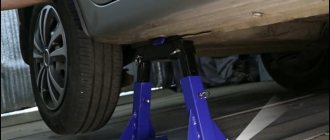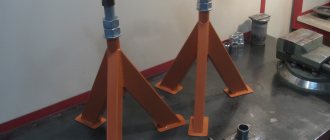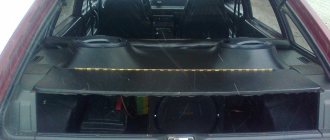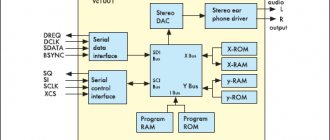Until recently, a USB connector in a car was considered almost a luxury. There is no such connector in many modern models, not to mention cars produced 10-15 years ago. In this article I will tell you how to get 5 V for a USB connector from a 12 volt on-board network.
Many people install various devices in their cars that are powered by a cigarette lighter - a video recorder, a GPS navigator, and they also periodically need to connect a phone charger. And because There is only one cigarette lighter socket, buy a splitter, but this is not a solution, wires stretching across the dashboard not only distract and interfere, but can cause an accident.
As a rule, all these devices are designed for a voltage of 5 V (standard USB interface voltage), and a converter from 12 to 5 volts is contained in the plug of each of these devices. I suggest installing one 5 V power supply in the car and using it to power all necessary devices via USB or mini USB connectors.
Updated 07/30/2015. The information from the article is still relevant now, but an alternative solution has appeared - ready-made USB adapters with a connection to a 12 V network. We are not talking about cigarette lighter adapters, they were on the market at the time of the first publication, but about independent converter devices.
How to make and connect USB to a radio with your own hands
Nowadays, no one can be surprised by a radio in a car; it’s difficult to see a car without it. The latter's screen displays not only sound data.
In some versions, it displays speed, data about external light lights and much more. But in our digital age, not every one of them is able to support listening to music from USB.
It's good that many car radios can connect this type of input.
Why connect USB
Music in cars appeared back in the 70s of the last century. At first these were simple radio receivers with a small range of received waves, and they were installed only on executive Volgas.
Principle of operation
In the vast majority of cases, mains-powered adapters operate using a pulse circuit. This allows you to obtain lightweight, compact, economical devices. You have to pay for this with complicated circuitry and reduced reliability compared to transformer power supplies.
Most network chargers have the same structure:
- rectifier with filter;
- pulse generator;
- inverter;
- pulse transformer;
- secondary rectifier with filter;
- indication circuits;
- stabilization circuits (may be absent).
The rectifier is often made using a half-wave circuit - the power consumption of the charger is low, so this is sufficient. For the same reason, the capacity of the smoothing capacitor is small. The pulse generator is often circuitously combined with an inverter - the same transistor generates oscillations and switches the winding. But sometimes this unit is also built on a specialized microcircuit. The secondary rectifier is also usually half-wave to avoid unnecessary voltage drop across the diodes. Schottky diodes are used for the same purpose. In most cases, the indication circuits are an LED with a resistor.
Stabilization is carried out using pulse width modulation through feedback. In many schemes, an optocoupler is used to organize it. This ensures galvanic isolation of the output from the high-voltage part.
Making a USB socket in a car with your own hands
First, let's figure out what this concept even means - a USB socket? But nothing special in essence: a USB port on the car panel, equipped with a power line, but with an unused data line, that is, roughly speaking, a universal interface for powering all sorts of USB gadgets from small to large and, most importantly, for charging everything and everything that can be charged from USB: phones, photo/video equipment, mp3 players, etc.
- By the way, for something that by default is not charged from USB, but only from an outlet, you can always solder a USB charging cable corresponding to a specific device, just know the pinout - in general, it’s not difficult.
- So, let's get down to business with a long-standing idea... First, let's figure out the pinout of the USB connector.
As you can see from the first picture taken from the search engine, everything is simply outrageous! So, we need to use pins 1 and 4 of the connector: supply 1 with stabilized 5 volts, and connect 4 to ground. Where can I get stabilized 5V in a car?
To do this, we need a linear voltage stabilizer LM7805 and a couple of capacitances for it, namely: two low-capacity ceramic capacitors at the input and output of the stabilizer to smooth out high-frequency interference, and preferably an electrolytic capacitor of not very large capacity at the input to smooth out low-frequency interference, which car on-board network is far from uncommon.
As can be seen from the picture, the stabilizer is a three-legged radio component, it has an input, an output and a mass. We assemble the whole thing and hang the electrolyte at the input.
In principle, this could have been enough, but Vlad, somewhere on the Internet, came up with a circuit for charging the now popular I-Pod mp3 players. As it turned out, Apple products are slightly more capricious and require special conditions, namely: raising the voltage on the USB Data pins (2 and 3) to 2V, which will represent the charging control signal for the I-Pod device.
- This is realized by connecting these two legs to stabilized 5V through resistors of certain values. Fewer words, the diagram will say much more, more concisely and faster:
- Actually, at the beginning of our journey we had (still separately from each other) the following:
- — linear voltage stabilizer LM7805; — ceramic capacitor 0.1 μF — x2; — electrolytic capacitor 470uF, 16V; — resistor 75KOhm — x2; — 51KΩ resistor (closest to 49.9) — x2; — two-port USB interface; - a piece of aluminum plate for use as a radiator for the stabilizer, which tends to get very hot during operation;
- - a piece of heat shrink of the required diameter.
- Vlad, of course, put forward the desire to solder everything neatly on a small etched scarf using SMD radio components, but quite natural laziness and the seemingly simplicity of the enterprise took their toll, and we did everything on our knees, by hanging installation, and then wrapped it all in heat shrink.
For tablet
Why won't a phone charger work for a tablet? A very common question! For the most part, tablets use a different charging current. Usually it is 9 Volts and the same 1 - 2 Amperes at the output.
And as we already explained above, a smartphone requires 5 Volts; if you hypothetically “plug” a phone charger into a tablet, the latter’s controller will simply burn out! You end up with expensive repairs. Therefore, remember - you cannot use telephone chargers for tablet computers.
So what to do, how to charge?
How to make and connect USB to a radio with your own hands
Even today, there are some modern cars that are equipped with radios without a USB connector, not to mention older cars.
This state of affairs does not suit many car owners, which prompts them to search for possible solutions.
One of the available options for equipping a standard USB radio is to connect the input yourself; this is not difficult to do, but not all car radios accept this solution.
What is a USB input on a car radio?
Many car owners are faced with a situation where the standard radio in the car does not read music from a flash drive. And the whole problem is that the device simply does not have a USB input, i.e. it was not originally provided. Moreover, this situation is relevant not only for old cars, but also on modern foreign cars you can often find such a distinctive feature.
Almost everyone will agree that you want to listen to music in the car without any restrictions, but you can’t burn a lot on a CD. Yes, and disks in a car today are somehow inconvenient and outdated. What to do, is there a solution to the problem? After all, replacing a radio is not the cheapest pleasure and not everyone can afford it.
Below we will try to understand the situation in detail and find the optimal solution.
The photo shows an example of a standard Audi TT radio with a USB input, but even today there are some cars whose radios do not have a USB connector
Today, all kinds of electronic devices and devices do not exist and, of course, the problem outlined above has not remained aside. It is not necessary to change the standard radio; it is enough to simply improve the device. There are different options, which we will consider.
USB adapter from mp3 player for standard tape recorder
For this method, we need the simplest mp3 player that is capable of reading music files of the appropriate format from both a memory card and a flash drive. Important feature: the player must have an audio output (jack) for headphones.
It is from this that the signal will be taken and sent to the radio. It is worth noting that to perform the procedure you need at least minimal skills in working with a soldering iron in order to avoid short circuits with solder during the soldering process and damage to the insulation of wires, elements, etc.
We implement the player as follows:
- We disassemble the radio and remove the CD drive or tape drive from it (if the radio is a cassette).
- We take power from the standard device to power the player, the board of which is first removed from the case.
- Depending on the player's supply voltage, you will have to implement a voltage converter circuit. For example, the car's on-board network has 12 V, and the player is powered by a 3.6 V Li-ion battery.
- We take the sound signal from the output of the player and feed it to the AUX input of the radio. The connection requires a shielded wire, i.e. the wires must be braided. On the radio board you need to find the audio input contacts. We solder the wire from the player to them.
- We install the player board inside the radio, since after removing the CD drive, space will be freed up. For convenience, the USB connector itself is located in a hole intended for cassettes or disks.
- The wires must be connected carefully to avoid a possible short circuit.
- To control the player, the buttons are connected to unused buttons from the CD drive.
- All that remains is to assemble the radio, install it in place and you can enjoy the music, for which you just need to activate the AUX mode.
Installing USB in the radio is possible by introducing an mp3 player into the device
Thus, we assembled the USB adapter ourselves. With this connection method, the volume level on the radio should be lower, which will eliminate the loud signal at a high input signal level.
DIY adapter
Let's consider another option for connecting a flash drive. In this case, you will need a plug from standard headphones, tulip-type connectors and a 4-core copper braided wire.
The adapter will be made from these elements. For the procedure to be successful, the radio must have an AUX input. Before starting work, make sure that the headphone wire is not broken.
For this reason it is called a multimeter. The whole process is as follows:
- We remove the insulation from the headphone wire and see red and green conductors that correspond to the right and left channels (we cut off the headphones themselves). These conductors must be stripped and soldered to the middle contacts on the tulip connector.
- The braid of the main wire is connected to the steel base of the “tulip”.
- The finished adapter should have the following wiring: a signal from the right and left channels is supplied to the middle contacts of the “tulips”, and the steel base is the common contact.
- We connect an adapter to the external sound signal connector of the radio, with which you can connect any device: tablet, smartphone, player, etc.
- All that remains is to activate the AUX mode and you can listen to music.
From the above, you can understand that the radio must have an AUX input. But what if there is no such connector, how to connect an external signal source in this case? There is a way out of this situation, and you can do everything with your own hands. For this we need:
- audio jack (standard 3-pin stereo jack);
- wire for connections (2 in the screen);
- soldering iron and everything necessary for it (solder and flux);
- multimeter
To make AUX on the stock radio, you will need to remove the device
Once everything is prepared, you can begin dismantling the device. Let's look at the whole process using the standard Toyota Avensis radio as an example. To remove it you need to:
- Pry the decorative strip from the end on the right, pull it along its entire length and remove it.
- Remove the connector from the button responsible for heating the rear window.
- The radio is secured with two bolts. To unscrew them you need to use a screwdriver with a magnet. Otherwise the bolts will fall behind the panel.
- To ensure free access, the handbrake must be raised.
- Move the selector to the central position and press the Shift Lock button, while the ignition should be turned off. In the corner we pry up the selector panel by snapping the pistons.
- Disconnect the connector going to the ashtray and remove the panel.
- More fastening bolts will be visible from below, which we carefully unscrew.
- We take out the radio so that access to the connectors on the rear panel is provided.
- Disconnect all connectors.
Phone charger from cigarette lighter on MC34063
The MC34063 is a popular IC for designing small transformerless voltage converter circuits. It is universal, since on its basis it is possible to make step-up, step-down and inverting DC-DC voltage converters. The range of input and output voltages makes it easy to assemble a number of voltage converters based on this microcircuit at minimal cost, which are indispensable in everyday life.
Of course, all these designs can be bought in China, ready-made, but we won’t talk about that today; you can buy everything in China, but it’s more interesting to do it yourself.
What else can you recommend?
The circuit is quite simple and assembly is not difficult. Still, there are drivers who are afraid of electricians and never agree to such actions. The best way out of this situation is to carry a spare push-button telephone with a charged battery in the glove compartment.
It would be a good idea to purchase a solar panel charger; it is relatively inexpensive, but can help out in the most difficult situations. The main thing is to choose the right charging plug, since old-style mobile phones have peculiarities in their charging connectors.
This scheme will be useful for those who are often on the road, go to remote places on vacation, or simply find themselves in an unpleasant situation. There is no difficulty in assembling, the main thing is to connect the elements step by step, you can do it using a hinged method, it is not 220V and there will be no voltage shock, you will feel the maximum warmth from the parts. Just for fun, in your free time, try assembling the circuit in a garage to make sure of the simplicity and reliability of the method.
Video review of charging a mobile phone in the car:
Option with adapter
The adapter works not only with USB, but also with memory cards
Most factory radios may have a socket on the back. All work comes down to several actions:
- take the radio out of the car;
There will be sockets for connection on the back wall of the radio
- disconnect the disc player connector;
- In its place include a USB adapter.
The adapter can be placed like this
The advantages of this solution:
- The radio will “decide” that you just changed the player. Accordingly, if the radio supports MP3 playback from a disc, it will be able to play it from a flash drive.
- Some adapters, in addition to USB support, have memory card support. You can remove the card from the smart card described above and insert it into such an adapter.
But there is also a minus
Control protocols are different for different cars, so when you change cars, you will most likely have to change the adapter. But when buying a new car, this issue is not so important.











